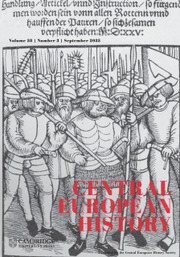In his new book, The Palatine Family and the Thirty Years' War: Experiences of Exile in Early Modern Europe 1632-1648, author Thomas Pert offers readers a nuanced and meticulously detailed account of the trials and hardships the Palatine family encountered as they were forced into exile. Set against the backdrop of the Thirty Years' War, Pert casts a wide geographic net, examining how the Pfalzfrage (the Palatine Question) became a central point of contention during the war as the Palatine family first lost, and then made every effort to regain, their lands and titles. Using the Palatine family as an example, Pert successfully argues that his study “provides valuable insight into the tactics used by early modern European dispossessed noble and royal houses in pursuance of their restoration, and how they marshalled the resources at their disposal to ensure the survival of their dynasty in spite of prolonged exile” (43). From the start, Pert's analysis shows to what lengths these families went to protect their legacies.
It is a complicated story, one that began in 1356 when then Holy Roman Emperor Charles IV issued a Golden Bull intended to regulate the imperial election process. The emperor's Bull confirmed the four secular voters of imperial elections: the King of Bohemia, the Duke of Saxony, the Margrave of Brandenburg, and the Count Palatine of the Rhine. The three ecclesiastical electors were the archbishops of Mainz, Cologne, and Trier.
By the outbreak of the Thirty Years' War in 1618, the Palatinate was the smallest of the four secular electorates, the result of divisions and sales following the Reformation, when the Palatinate had become one of the three Protestant electorates. At the war's outset, Frederick V had been Elector in his own right for four years. In one of his most important decisions as a young elector, Frederick had married Princess Elizabeth, the daughter of Britain's King James VI and I and sister to the ill-fated Charles I. As Pert deftly establishes, this dynastic alliance would prove to be both an advantage and a drawback for the future of the Palatine family.
It is also a compelling tale, one that Pert tells with care and attention. More decisive than his marriage, following the Defenestration of Prague, Frederick V was elected King of Bohemia in 1619. Frederick was twenty-three years old with a growing family and deep political connections. It was a fateful election for the Palatine prince, one that would define the rest of his short life and the lives of his wife and children. His rule lasted less than a year. The Battle of White Mountain in 1620 ended his reign, leaving him with the humiliating title of ‘The Winter King.’ Along with his loss of Bohemia, Frederick was also stripped of hereditary lands and titles through Emperor Ferdinand's Reichsacht, or Imperial Ban. “The ‘Winter King’ was now effectively a landless outlaw who was almost entirely dependent on the assistance of his family and supporters” (30).
Through the primary sources, most of which are letters that flew between the family and various supporters, and sharp analyses of the secondary sources that have often discounted the Palatine family following Frederick V's death in 1632, Pert reconstructs the family's ensuing struggles. Here Pert turns his focus on Elizabeth, who initially took up the family's cause. Between 1632 and the Peace of Westphalia in 1648, Pert highlights her efforts, along with her son, Charles Louis, to remain politically and socially relevant as their financial and political debts mounted.
Elizabeth lost her husband and several of her children during this period, yet she remained steadfast in her conviction that her family should not compromise. She wanted the Palatinate with its titles returned intact, a demand that was, as Pert notes, impossible. Yet she never wavered. She turned most notably to her brother, Charles I, King of Britain, for support. Busy with his own political troubles, Charles offered sporadic aid to his sister. The English Parliament also became involved, complicating negotiations between the Palatine family and the British crown.
In the end, the Peace of Westphalia offered mixed results for the return of the Palatinate to Elizabeth's son, Charles Louis. Pert carefully re-evaluates historians' earlier accounts that deemed the Peace a failure for the dynasty. Rather, in Pert's estimation, the Peace provided Charles Louis with some restitution, if not all. He regained the Lower Palatinate and a “newly created eighth electoral title, which was to be the lowest in the order of precedence in the Electoral College” (218). For Elizabeth, however, it was a bitter blow as she continued to demand full restitution.
What followed was what one might expect of noble families that had fought for so long to restore their titles and lands: they fell to bickering over the partial restoration and their financial troubles as a result of the war. Elizabeth, who had spent most of her exile in The Hague, continued to amass enormous household debts, over which she and Charles Louis argued endlessly. Finally, their dispute “led Elizabeth to retire to her homeland, rather than returning to the Palatinate, demonstrating how the experience and legacy of exile could tear ruling dynasties apart” (258). Yet, for her family and its future, the saga of their restoration continued, as it did for so many other noble exiles in the seventeenth century. Their stubborn survival led Pert to conclude that “exiled rulers were not automatically rendered politically insignificant after losing their lands and titles” (258). Instead, through the intersections of political machinations, intrigue, media, and blind belief in their cause, these dynastic houses were able to maintain certain levels of political agency, making them worthy of re-examination.


